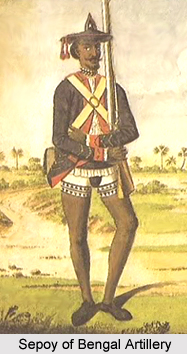 The Bengal Artillery was one of the army units of the British East India Company. It served as a part of the Bengal Army which was the military of the Bengal Presidency. The army of Bengal Province was among the three major Presidency Armies of British India. The first company of the regiment was formed in 1749 under the administrative authority of the East India Company. The artillery regiment consisted of the Bengal Native Foot Artillery, Bengal Horse Artillery, Punjab Horse Artillery, Punjab Irregular Force and the Bengal European Foot Artillery. The uniform of the troops included blue formal dress with scarlet facings.
The Bengal Artillery was one of the army units of the British East India Company. It served as a part of the Bengal Army which was the military of the Bengal Presidency. The army of Bengal Province was among the three major Presidency Armies of British India. The first company of the regiment was formed in 1749 under the administrative authority of the East India Company. The artillery regiment consisted of the Bengal Native Foot Artillery, Bengal Horse Artillery, Punjab Horse Artillery, Punjab Irregular Force and the Bengal European Foot Artillery. The uniform of the troops included blue formal dress with scarlet facings.
History of Bengal Artillery
The troops of Bengal Artillery perished in the Black Hole Tragedy of Calcutta (now at Fort William, Kolkata). However later in 1765, it was re-established with four companies. A fifth company of the unit was raised in 1770 and a battalion was developed. The regiment was re-organised in 1778 and consisted of one European Regiment and three Native battalions. The European Regiment included seven field companies and one mounted company; while the Native battalions included eight companies each. The regiment was again re-structured in 1779. It consisted of two European battalions and each battalion included five companies. The regiment was included as one of the brigades of the presidency Armies in British India.
Development of Bengal Artillery
After the Sepoy Mutiny in 1857, almost all of the units of the Bengal Army were disbanded because of the involvement of the troops in the revolt. All of the sepoy artillery regiments were dissolved and the European battalions were incorporated as a part of the Royal Artillery. The Bengal Artillery was merged with the Royal Artillery in 1862 as the 16th Brigade, 19th Brigade, 24th Brigade and 25th Brigade.
Officers of Bengal Artillery
The British officers of the Bengal Artillery are listed as follows-
* James Abbott (Indian Army officer)
* George Willoughby
* Hastings Edward Harrington
* Proby Cautley
* Charles Edward Nairne
* John William Kaye
* Henry Montgomery Lawrence
* Charles Pratt Kennedy
* Henry Tombs
* Edward Montagu (Indian Army officer)
* Richmond Shakespear
* William Olpherts
* Frederick Roberts, 1st Earl Roberts
* George Pollock



















